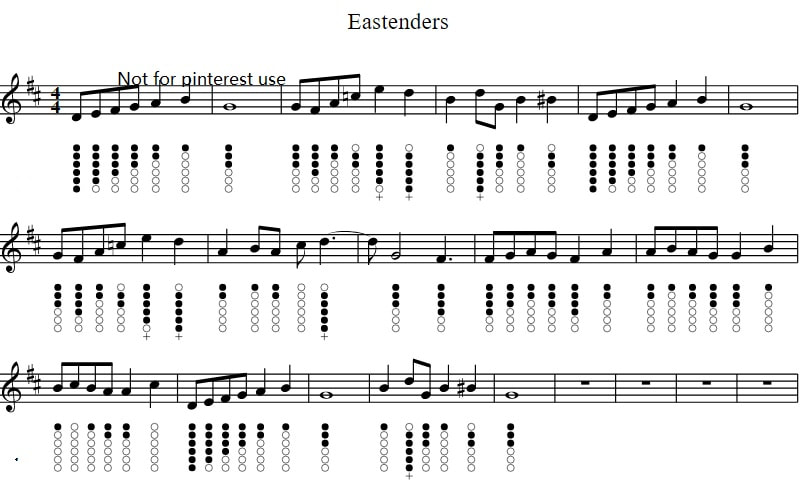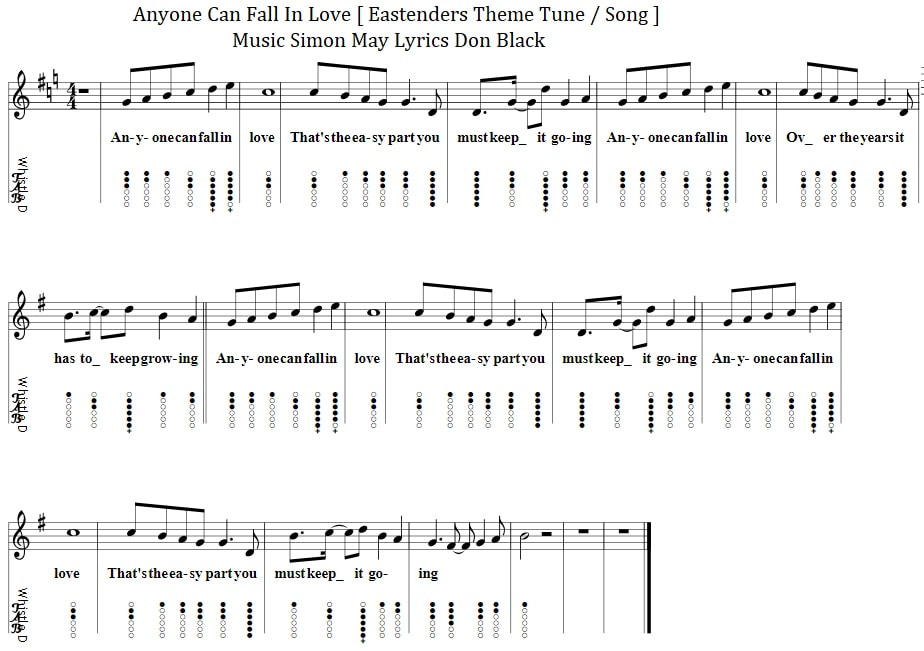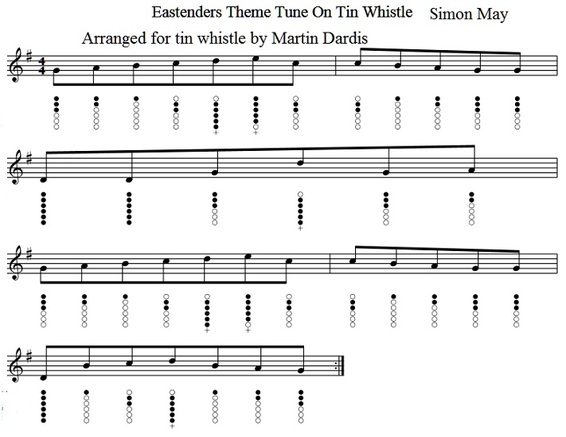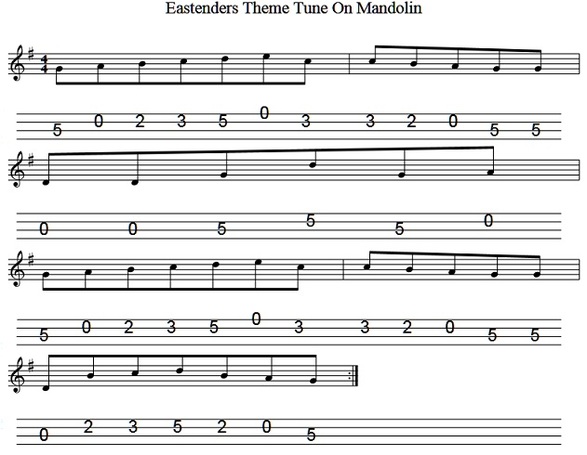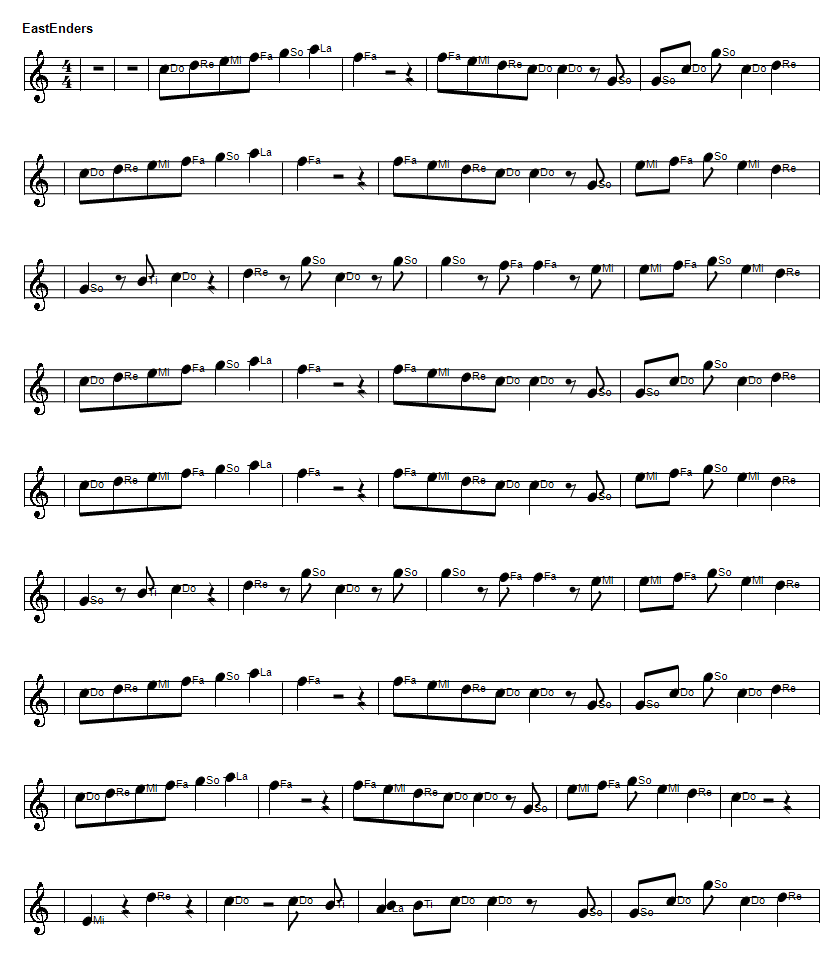Eastenders Theme Tune Tin Whistle Sheet Music
Written by Simon May. The mandolin sheet music is also included. If anybody who is familiar with the tune and would try it out for me that would be great. This was a request and I don't watch Eastenders so I'm not too sure if I got it right. Let me know please. The version that's played at the start of the T.V. programme is in the key of C, this version was worked out on a D whistle. If you're playing this on a piano then I remind you that there are no sharps # and all the keys are white. More pop songs with sheet music for tin whistle. Eastenders sheet music notes in the solfege style of Do Re Mi included. Anyone Can Fall In Love Sheet Music With Lyrics Now Included Which Uses Eastenders Theme Tune And Was Recorded By Anita Dobson.
Introduction
Music has always been an integral part of television shows and has the power to evoke emotions, set the tone, and create a sense of familiarity for viewers. One such iconic television theme tune is that of the British soap opera, Eastenders. The show has been on the air for over 35 years and its theme tune has become synonymous with it. In this thesis, we will explore the history, composition, significance, and impact of the Eastenders theme tune on the show, its viewers, and popular culture.
History and Composition
The theme tune of Eastenders was composed by Simon May, with lyrics by Leslie Osborne and Don Black. The show’s creators, Julia Smith and Tony Holland, wanted a theme tune that would reflect the gritty and realistic nature of the show, set in the fictional working-class neighborhood of Albert Square in London's East End. Simon May was approached to compose the theme tune as he had previously worked on successful television theme tunes such as 'Howard's Way' and 'Animal Magic.'
May composed the iconic melody on his piano in just ten minutes, and it has remained unchanged since its inception in 1984. The theme tune features a catchy and memorable piano riff, accompanied by a saxophone solo, and the iconic drum beats that mimic the sound of a heartbeat. The lyrics, 'Anyone can fall in love / That's the easy part you must keep it going / Anyone can fall in love / Over and over again' were chosen to reflect the ongoing romantic storylines of the show.
Significance and Impact
The Eastenders theme tune has become an integral part of the show and has been played at the beginning and end of every episode since its premiere in 1985. It has become an instantly recognizable tune, not only in the UK but also around the world, as the show has been broadcasted in over 100 countries. The theme tune has become so iconic that it has been parodied and referenced in popular culture, including in other television shows and films.
One of the main reasons for the theme tune's success is its ability to capture the essence of the show and its characters. The catchy and upbeat melody contrasts with the show's dark and dramatic storylines, creating a sense of irony. It also sets the tone for the show, signaling to viewers that they are about to enter the world of Eastenders. The lyrics, with their message of love and the struggles of maintaining it, also resonate with the show's themes of family, relationships, and community.
Moreover, the Eastenders theme tune has become a cultural symbol of British television and has been used to represent the working-class and urban culture of the East End. The show's success and longevity can also be attributed, in part, to the theme tune, as it has become a familiar and comforting sound for viewers over the years.
Conclusion
In conclusion, the Eastenders theme tune is not just a catchy melody, but it has become an essential part of the show's identity and has had a significant impact on popular culture. Its simple yet effective composition, coupled with its ability to capture the essence of the show and its characters, has made it a timeless and iconic tune. It has become a cultural symbol of British television and has contributed to the show's success and longevity. The Eastenders theme tune will continue to be played for years to come, evoking emotions and setting the tone for viewers as they tune in to watch the ongoing drama of Albert Square.
Music has always been an integral part of television shows and has the power to evoke emotions, set the tone, and create a sense of familiarity for viewers. One such iconic television theme tune is that of the British soap opera, Eastenders. The show has been on the air for over 35 years and its theme tune has become synonymous with it. In this thesis, we will explore the history, composition, significance, and impact of the Eastenders theme tune on the show, its viewers, and popular culture.
History and Composition
The theme tune of Eastenders was composed by Simon May, with lyrics by Leslie Osborne and Don Black. The show’s creators, Julia Smith and Tony Holland, wanted a theme tune that would reflect the gritty and realistic nature of the show, set in the fictional working-class neighborhood of Albert Square in London's East End. Simon May was approached to compose the theme tune as he had previously worked on successful television theme tunes such as 'Howard's Way' and 'Animal Magic.'
May composed the iconic melody on his piano in just ten minutes, and it has remained unchanged since its inception in 1984. The theme tune features a catchy and memorable piano riff, accompanied by a saxophone solo, and the iconic drum beats that mimic the sound of a heartbeat. The lyrics, 'Anyone can fall in love / That's the easy part you must keep it going / Anyone can fall in love / Over and over again' were chosen to reflect the ongoing romantic storylines of the show.
Significance and Impact
The Eastenders theme tune has become an integral part of the show and has been played at the beginning and end of every episode since its premiere in 1985. It has become an instantly recognizable tune, not only in the UK but also around the world, as the show has been broadcasted in over 100 countries. The theme tune has become so iconic that it has been parodied and referenced in popular culture, including in other television shows and films.
One of the main reasons for the theme tune's success is its ability to capture the essence of the show and its characters. The catchy and upbeat melody contrasts with the show's dark and dramatic storylines, creating a sense of irony. It also sets the tone for the show, signaling to viewers that they are about to enter the world of Eastenders. The lyrics, with their message of love and the struggles of maintaining it, also resonate with the show's themes of family, relationships, and community.
Moreover, the Eastenders theme tune has become a cultural symbol of British television and has been used to represent the working-class and urban culture of the East End. The show's success and longevity can also be attributed, in part, to the theme tune, as it has become a familiar and comforting sound for viewers over the years.
Conclusion
In conclusion, the Eastenders theme tune is not just a catchy melody, but it has become an essential part of the show's identity and has had a significant impact on popular culture. Its simple yet effective composition, coupled with its ability to capture the essence of the show and its characters, has made it a timeless and iconic tune. It has become a cultural symbol of British television and has contributed to the show's success and longevity. The Eastenders theme tune will continue to be played for years to come, evoking emotions and setting the tone for viewers as they tune in to watch the ongoing drama of Albert Square.
Anyone Can Fall In Love Eastenders Sheet Music - The lyrics version below will make it easier to play the song.
PDF Sheet Music For Eastenders Theme Tune
| theme_from_east_enders.pdf |
Eastenders sheet music notes in Do Re Mi solfege format
